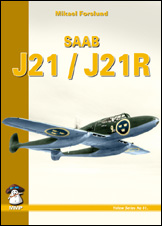Ouvrage indisponible (réimpression)
Even if Sweden saw its neutrality respected by all during WW2, that doesn’t mean that Sweden did not tried to expend its armed forces during these critical years. By the end of the thirties, Sweden began to purchase subsequent numbers of aircraft from all sides to equip actual and future units, but these efforts were frustrated when war broke out, and one after one, orders were embargoed, the last of the country in doing so were the United States in October 1940. However, Sweden was concerned about the future and continued to will to expend its air force in the aim to protect the country. It became clear that the Swedes had to go on their own as for combat aircraft and many projects were launched by the Swedish industry.
The SAAB J-21 was born from this situation. When it appeared, it was a very unconventional prop-driven aircraft at that time. The J-21 has the particularity in having an operational jet-prop derivative, becoming one a the very few aircraft of that kind.
Mikael Forslund explains the career of the J-21 in the sole operator knew, Sweden. As for all the other books of this series, many details and explanations are given with very interesting recollections from the pilots. The text is very instructive even if more details about the accident or a summary on them would have been appreciated. A large number of photographs are coming in to illustrate the book, backed with colour profiles and for the modellers, an usual part showing parts of surviving aircraft. Line drawings are also included, 1/72 in the book, and 1/48 in a separate sheet.
Even if the SAAB J-21 was never engaged in kind of combat and remains an oddity comparing to other major aircraft of that time, this remains probably the best book available on the market on this aircraft.
Phil Listemann
144 pages, B5, softcover
in English
Le déclenchement de la Seconde guerre mondiale a eu des conséquences fâcheuses pour la Suède, dont la neutralité a été pourtant respectée tout au long du conflit, neutralité rappelons-le refusée à ses deux voisins, la Norvège envahie par les Allemands et la Finlande emportée par un conflit sans fin avec l’Union Soviétique.
À partir de 1939, l’un après l’autre, tous les pays européens belligérants, suivis fin 1940 par les États-unis, décrètent l’embargo sur les armes à destination de la Suède, ce qui compromit le développement de ses forces aériennes alors en cours. N’estimant pas sa neutralité acquise, la Suède n’eut alors pas d’autre choix que de développer ses propres projets d’avions de combat, démarche dont le SAAB J-21 sera issu.
Mikael Forslund retrace l’histoire complète de cet avion original à la silhouette peu orthodoxe, qui n’a d’ailleurs servi qu’en Suède. Cet appareil présente également une particularité originale: c’est l’un des rares avions opérationnels à moteur à pistons a avoir connu un dérivé opérationnel doté d’un réacteur, le J-21R.
Ce livre de 144 pages reste fidèle aux publications Mushroom de la « collection jaune », avec un texte explicatif riche en informations sur la genèse, le développement et l’utilisation opérationnelle, illustré de nombreux témoignages et photos, ainsi que de quelques profils, peu nombreux cependant dans ce livre, ce qui est inhabituel chez Mushroom. L’habituel « cahier spécial » destiné aux maquettistes offre des clichés des différentes parties des avions préservés. On peut aussi regretter le manque de précision sur les accidents ; cela aurait enrichi grandement cette étude. À noter sur un feuillet séparé, des dessins au trait des J-21A et J-21R au 1/48e (les mêmes au 1/72e étant intégrés au livre). Ceci étant, cela reste un bon livre pour celui qui veut faire connaissance avec un avion dont l’emploi fut limité mais qui sort sans aucun doute de l’ordinaire.
Philippe Listemann
144 pages, B5 (25 x 17,6 cm), couverture souple
en anglais



